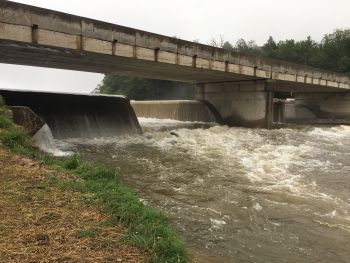Water Conveyance: Difference between revisions
No edit summary |
No edit summary |
||
| (2 intermediate revisions by one other user not shown) | |||
| Line 10: | Line 10: | ||
<!-- Add picture caption --> | <!-- Add picture caption --> | ||
|caption=Flow over a labyrinth weir at Lake Scranton Dam. | |caption=Flow over a labyrinth weir at Lake Scranton Dam. | ||
(Image Source: Gannett Fleming) | |||
}} | }} | ||
<!-- Delete any sections that are not necessary to your topic. Add pictures/sections as needed --> | <!-- Delete any sections that are not necessary to your topic. Add pictures/sections as needed --> | ||
Water conveyance is an important and essential design component of a dam for a variety of reasons including: the consumption of water resources, the controlled release of attenuated flood surges during large [[precipitation]] events, regular [[environmental]] releases for maintaining riverine ecosystem health, hydropower generation, or emergency drawdown of the reservoir to prevent a catastrophic failure of the dam. | Water conveyance is an important and essential design component of a dam for a variety of reasons including: the consumption of water resources, the controlled release of attenuated flood surges during large [[precipitation]] events, regular [[environmental]] releases for maintaining riverine ecosystem health, hydropower generation, or emergency drawdown of the reservoir to prevent a catastrophic failure of the dam. | ||
Although necessary for proper [[operation]] of a dam, water conveyance features often add complexity and introduce discontinuities in a dam structure; thereby introducing potential areas of weakness where potential failure modes initiate. Because of this, the proper design and [[construction]] of water conveyance structures are critical to the safety of a dam. | |||
==Types of Water Conveyance== | ==Types of Water Conveyance== | ||
Depending on the type of release, different means of water conveyance can be used as follows: | |||
*[[Outlet Works]] | *[[Outlet Works]] | ||
Latest revision as of 17:57, 28 July 2023

|
| Flow over a labyrinth weir at Lake Scranton Dam.
(Image Source: Gannett Fleming) |
Water conveyance is an important and essential design component of a dam for a variety of reasons including: the consumption of water resources, the controlled release of attenuated flood surges during large precipitation events, regular environmental releases for maintaining riverine ecosystem health, hydropower generation, or emergency drawdown of the reservoir to prevent a catastrophic failure of the dam.
Although necessary for proper operation of a dam, water conveyance features often add complexity and introduce discontinuities in a dam structure; thereby introducing potential areas of weakness where potential failure modes initiate. Because of this, the proper design and construction of water conveyance structures are critical to the safety of a dam.
Types of Water Conveyance
Depending on the type of release, different means of water conveyance can be used as follows:
- Outlet Works
- Gates/Bulkheads
- Spillways
- Overtopping Protection
- Siphons
- Penstocks
- Flumes
- Canals
- Tunnels
- Energy Dissipation
Trainings
![]() On-Demand Webinar: Hydraulics 101: Intro to Hydraulics for Dam Safety
On-Demand Webinar: Hydraulics 101: Intro to Hydraulics for Dam Safety
![]() On-Demand Webinar: Hydraulics 201 for Dam Safety
On-Demand Webinar: Hydraulics 201 for Dam Safety
Revision ID: 7472
Revision Date: 07/28/2023
